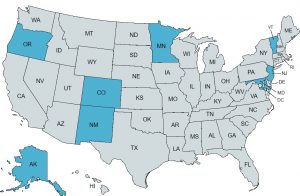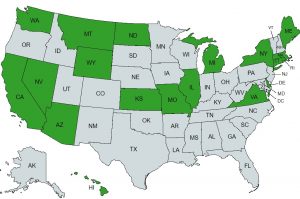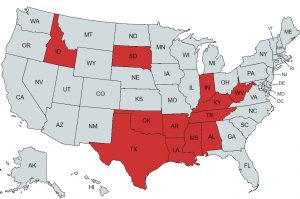SPOTLIGHT ON ABORTION CARE & REPRODUCTIVE JUSTICE
Voters Win Abortion Care Protection in 7 More States
Now 14 of 17 States Succeed in Guaranteeing Right to Abortion Care
Written by Sarah Osborn, AMSA Gender & Sexuality Action Committee, Reproductive Justice Coordinator
This election will lead to major changes. Be there for yourself, your friends, and your family. Here at AMSA, we are your family, and the Reproductive Health Project will be here as we move ahead to provide you up to date information and to actively work to protect Reproductive Freedom.
June 2022 marked a catastrophic event for Reproductive Health in our nation. When the U.S. Supreme Court overturned Roe v. Wade, states gained control of abortion access, leading to the loss of reproductive rights across nearly half the states in our country. On Nov. 5, 10 states had abortion care measures on the ballot, and 7 of those prevailed, leading to greater access to abortion care for people in need in those states.
In a previous spotlight, Abortion is on the Ballot in 10 States: Get the Facts, we shared details, along with the passage requirements. The 7 ballot measures passed will go into effect in line with state procedures, Nevada requires a second vote on ballot measures to get solidified into their constitution so it will be up on the ballot again in 2026, and 3 states did not pass abortion measures on their ballot.
State Abortion Care Ballot Measures that Passed Nov. 5:
- Arizona Proposition 139: passed with 61.2% of votes leading to the state constitution being amended to include a fundamental right to abortion up until fetal viability. Also includes exceptions after fetal viability to protect the life of the pregnant person.
- Colorado Amendment 79: passed with 61.9% of votes leading to the state constitution being amended to include the right to abortion and removal of the current ban on medicaid and state employees insurance covering abortion.
- Maryland Question 1: passed with 74.5% of votes leading to the state constitution being amended to include a fundamental right to reproductive freedom which includes abortion and birth control.
- Missouri Amendment 3: passed with 51.7% of votes leading to the state constitution being amended to include providing a fundamental right to abortion up to fetal viability. Also includes exceptions after fetal viability to protect the life of the pregnant person. And includes protections against any pregnancy outcome for the pregnant person or anyone assisting them.
- Montana CI-128: passed with 58.6% of votes leading to the state constitution being amended to include the right to abortion up to fetal viability and after viability to protect the life of the pregnant person. Also includes protection from the government for any pregnancy outcome.
- Nevada Question 6: passed with 64.0% of votes leading, but requires a second vote and passage in 2026 to become effective. This would amend the state constitution to include the right to an abortion up to fetal viability and after viability to protect the life of the pregnant person.
- New York Proposal 1: passed with 61.9% of votes to add protections for discrimination and prohibit discrimination by the government based on pregnancy and pregnancy outcomes. Prevents any government actions that would limit access to reproductive health care.
Nebraska’s 2 Opposing Ballot Measures – 1 Passed, 1 Didn’t
- Initiative 439 Right to Abortion: Not passed with only 48.8% voting for amending the constitution to protect the right to abortion until fetal viability or after to protect the health of the pregnant person.
- Initiative 434 Prohibit Abortions After the First Trimester Amendment: Passed with 55.3% of votes leading to abortion banned after the first trimester with exceptions for medical emergency, sexual assault, or incest.
Ballot Measures Not Passed
- Florida Amendment 4: did not pass with 57.2% of people voting yes, but was short of the 60% supermajority needed to create a constitutional amendment to protect abortion access up to fetal viability and after to protect the health of the pregnant person.
- South Dakota Amendment G: did not pass with 41.4% of people voting yes, therefore a right to abortion before 12 weeks of pregnancy, or after to protect the life of the pregnant woman did not pass.
Since the overturn of Roe v. Wade, 17 states have tried to protect abortion care in their state, and after this most recent election 14 have done so, with 11 being constitutional amendments. This has changed the current abortion law map in the US, but there’s still more work to be done.
Where Current State Abortion Gestational Bans Stand Now
(Other abortion bans, restrictions, exemptions, or protections are not included here)
States with No Abortion Gestational Bans:
- Alaska
- Colorado
- Maryland
- Minnesota
- New Jersey
- New Mexico
- Oregon
- Vermont
States Where Abortion is Legal Until Fetal Viability: 
- Arizona
- California
- Connecticut
- Delaware
- Kansas
- Hawaii
- Illinois
- Maine
- Massachusetts
- Michigan
- Missouri
- Montana
- Nevada
- New York
- North Dakota (Total ban currently enjoined)
- Rhode Island
- Virginia
- Washington
- Wyoming (Total ban currently enjoined)
States with Total Gestational Abortion Bans: 
- Alabama
- Arkansas
- Idaho
- Indiana
- Kentucky
- Louisiana
- Mississippi
- Oklahoma
- South Dakota
- Tennessee
- Texas
- West Virginia
Where Abortion is Legal Until 6-weeks LMP (last menstrual period):
- Iowa
- Florida
- Georgia
- South Carolina
Where Abortion is Legal Until 12-weeks LMP (First Trimester):
- Nebraska
- North Carolina
Where Abortion is Legal Until 18-weeks LMP:
- Utah (Total ban currently enjoined)
Where Abortion is Legal Until 20-weeks post-fertilization:
- Wisconsin
Where Abortion is Legal Until 22-weeks LMP
- Ohio
Where Abortion is Legal Until 24-weeks LMP
- Pennsylvania
- New Hampshire
To learn more about state abortion ballot measures visit the
AMSA Gender & Sexuality Action Committee
###
Explore the AMSA Reproductive Health Project
Find news, tips, tools, opportunities & more!
Sign-up Here for AMSA Repro Project Updates
